Renewable Energy Training Package, Advanced Users, 10 Practical Exercises
$667.00 Student Discount
This training package, including 10 different practical exercises for ADVANCED users, insets Computational Fluid Dynamics (CFD) methods and materials for designing, simulating, and dissecting applied and Renewable Energy Engineering CFD projects, with practical experiments using ANSYS Fluent software.
Click on Add To Cart and obtain the Geometry file, Mesh file, and a Comprehensive ANSYS Fluent Training Video.To Order Your Project or benefit from a CFD consultation, contact our experts via email ([email protected]), online support tab, or WhatsApp at +44 7443 197273.
There are some Free Products to check our service quality.
If you want the training video in another language instead of English, ask it via [email protected] after you buy the product.
Description
Renewable Energy – ANSYS Fluent Training Package, 10 Practical Exercises for ADVANCED Users
This training package, including 10 different practical exercises for ADVANCED users, insets Computational Fluid Dynamics (CFD) methods and materials for designing, simulating, and dissecting applied and Renewable Energy Engineering CFD projects, with practical experiments using ANSYS Fluent software.
In the INTERMEDIATE package, we investigate the WIND energy. So, in the ADVANCED package, we are going to study the WATER and SOLAR energies.
Water Energy (Renewable Energy)
Water Turbine
AST
In project number 1, an Archimedes Screw Turbine consisting of 3 blades is simulated in two models. The first model is unsteady Frame Motion (MRF), and the second one is an unsteady Mesh Motion. Considering the conception of both methods, the turbine in the frame-motion method is in a stationary state, and the fluid around it is rotating, while in the Mesh Motion method, the rotating zone that contains the Screw Turbine rotates independently.
Pelton Wheel
A PELTON Wheel is simulated in practical exercise number 2. The water wheel is an example of Pelton turbines. Most water wheels are mounted vertically on a horizontal axis, and can also be mounted horizontally on a vertical shaft.
HAWT
Study number 3 investigates the water flow on the Horizontal axis WATER turbine (HAWT) blades so that the purpose of the problem is to investigate the distribution of velocity and pressure on the wall of the blade. There are two areas around the blades, including a cylindrical area just around the blades and a large area around the cylinder. The flow of water in the large outer space behaves like a normal flow, while in the cylindrical region around the blades, the rotational flow is caused by the rotational motion of the blades.
VAWT
Problem number 4 simulates the water flow around a Vertical axis WATER turbine submerged in water using the DYNAMIC MESH method. The water turbine is from the category of vertical axis turbines and is of the Darrieus type; So that the axis of the turbine is perpendicular to the direction of water flow.
Study number 5 investigates the water flow around a vertical water turbine considering unsteady CFD simulation and FLUID SOLID INTERACTION (Fluid Structure Interaction). In the present case, it is assumed that the turbine blades are affected by the flow of the passing fluid; that is, the fluid flowing through the turbine blades impedes forces on the turbine body and these forces cause deformation or resizing of the body of these blades. Therefore, the present problem consists of two fluid and solid solutions at the same time and hence, the FSI method and the coupling between the fluid flow and the Transient Structural are used.
Solar Energy (Renewable Energy)
Solar Still & Desalination
Study number 6 investigates the performance of a 2-D solar-still thermal desalination unit. The present model consists of a small chamber with a sloping glass surface at the top. The solar heat passes through the glass to the surface of the water in the enclosure and causes surface evaporation (applying a UDF for surface evaporation). Study number 7 investigates the performance of a 3-D solar-still thermal desalination unit. The resulting vapor impact the cold glass surface and undergo a distillation process. Pure water from hot vapor distillation moves down the slope of the glass plate and discharges as pure water.
In project number 8, the surface evaporation process in a 2D solar desalination system is simulated and analyzed. In this process the surface of the fluid water will receive the warmth of solar rays, then based on the principles of surface evaporation, the water molecules on the surface of the water will start to evaporate. Finally, when the gauge pressure and temperature of water vapor reach 3000 Pa and 343.15 K respectively, it will leave the desalination system through the defined pressure outlet. Study number 9 investigates the performance of a STEP solar desalination unit. The present model consists of a small chamber with a sloping glass surface on both sides and steps within it, where saline water flows on the surface of these steps. Solar radiation heat transfer passes through the glass to the surface of the water in the enclosure to evaporate the water surface on the step walls.
Solar Collector
Finally, problem number 10 simulates heat transfer within a PCM solar collector. The current model consists of a U-shaped tube that carries water flow. Around this U-shaped tube, a cylindrical space is used, composed of phase change material (PCM).
[/vc_column_text][/vc_column][/vc_row]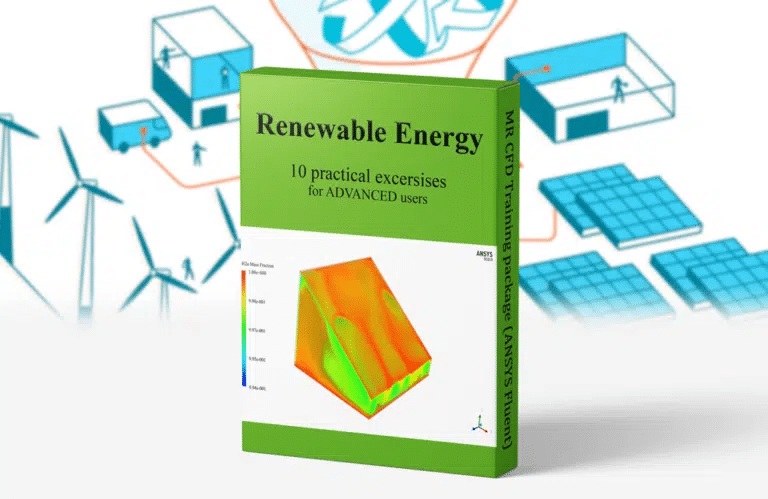
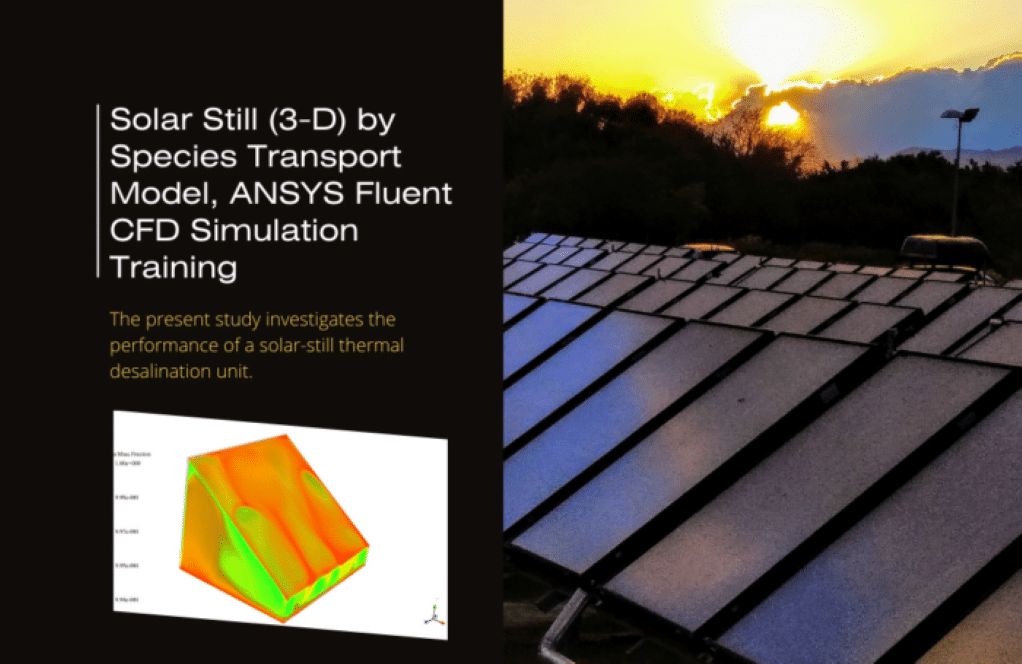
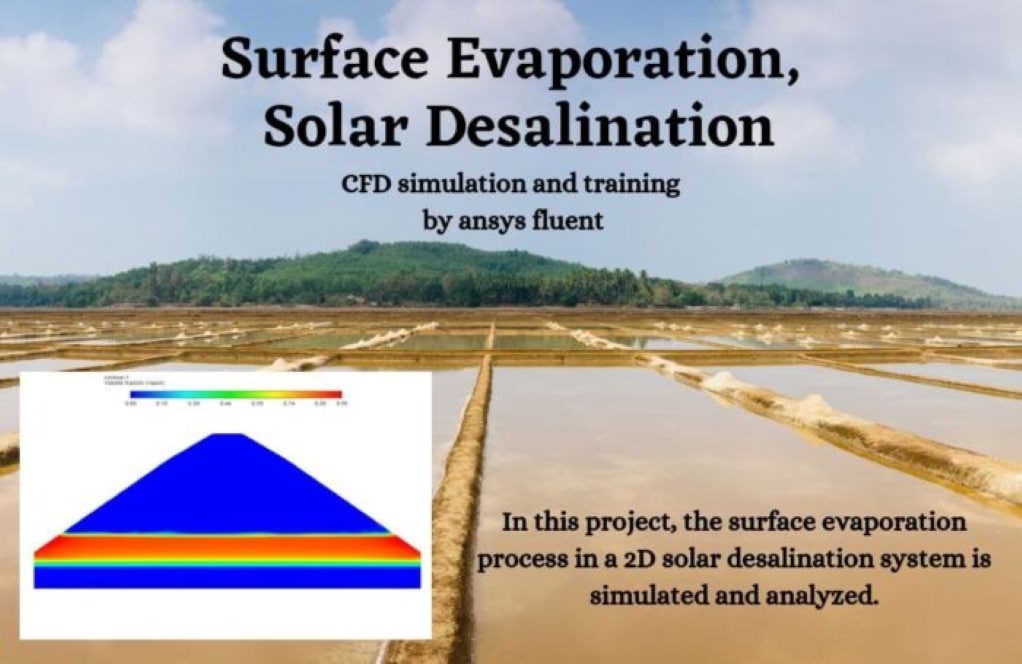
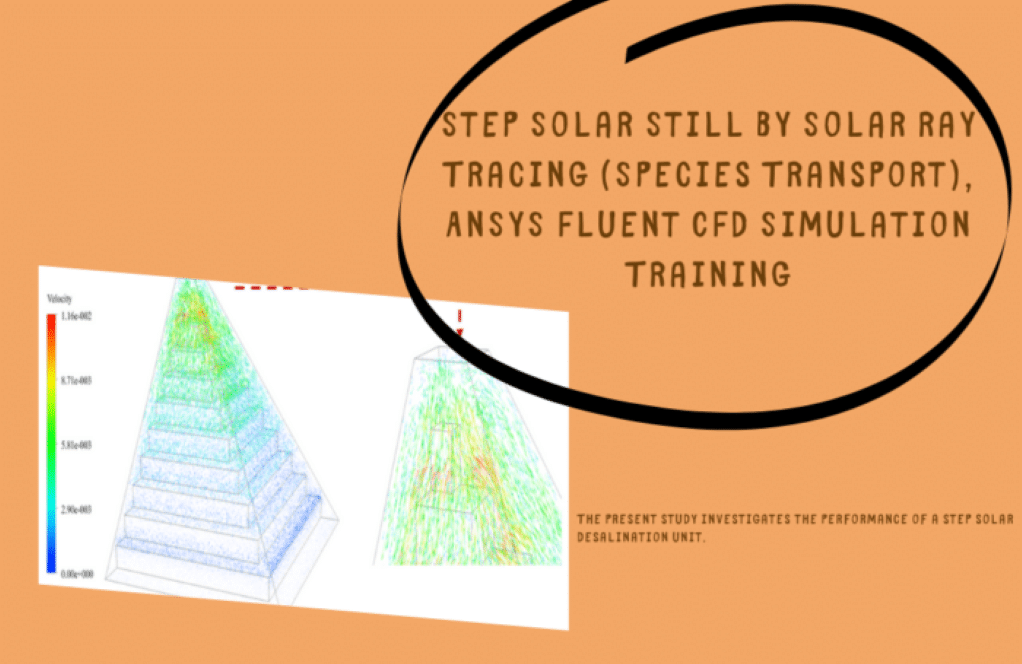
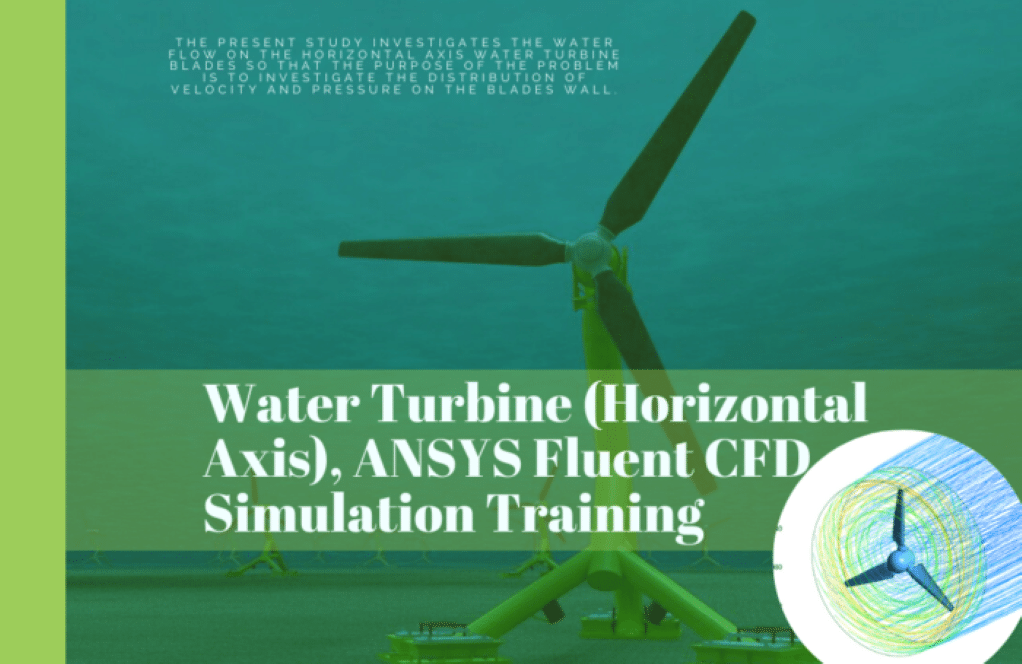
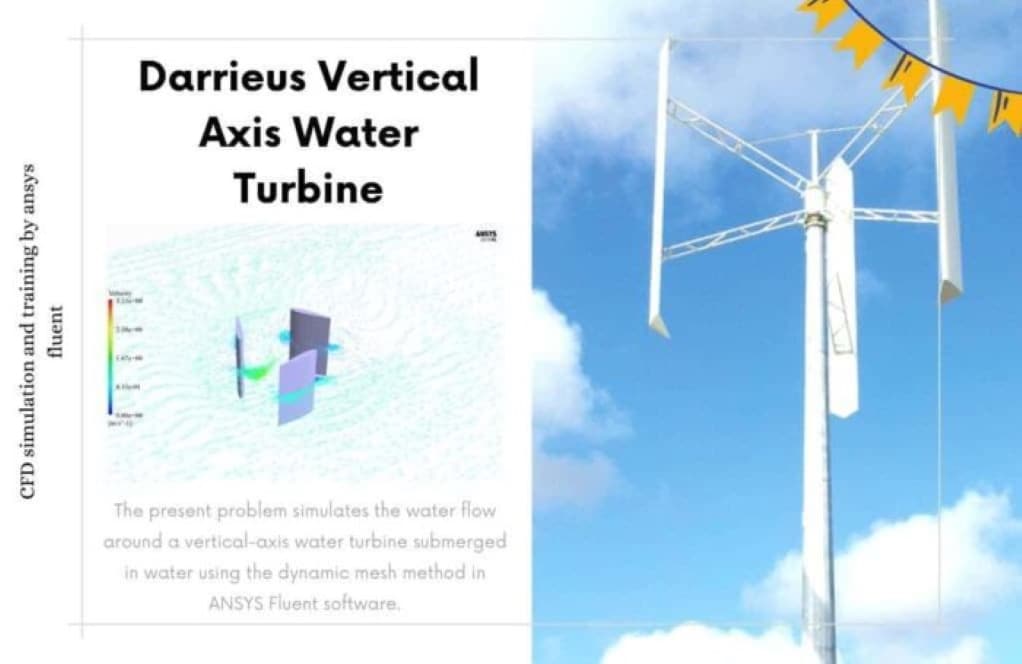
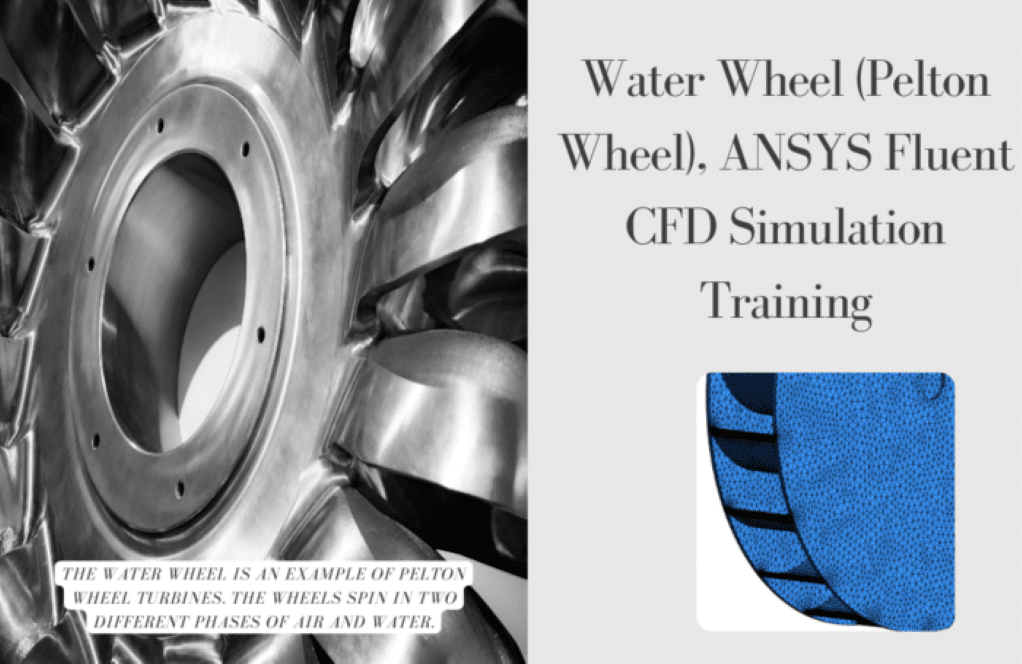
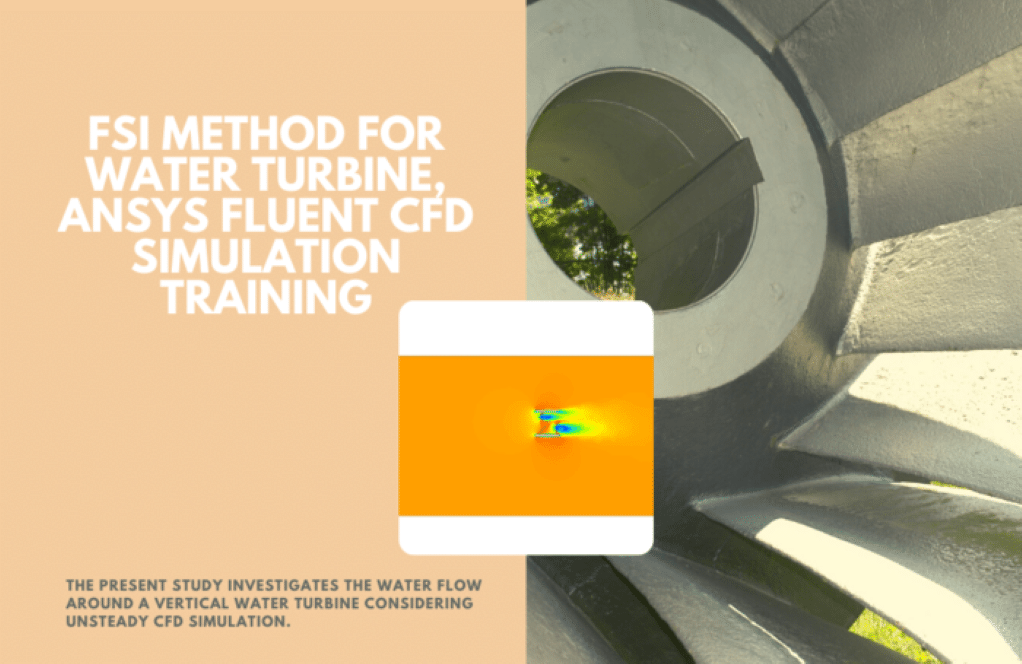
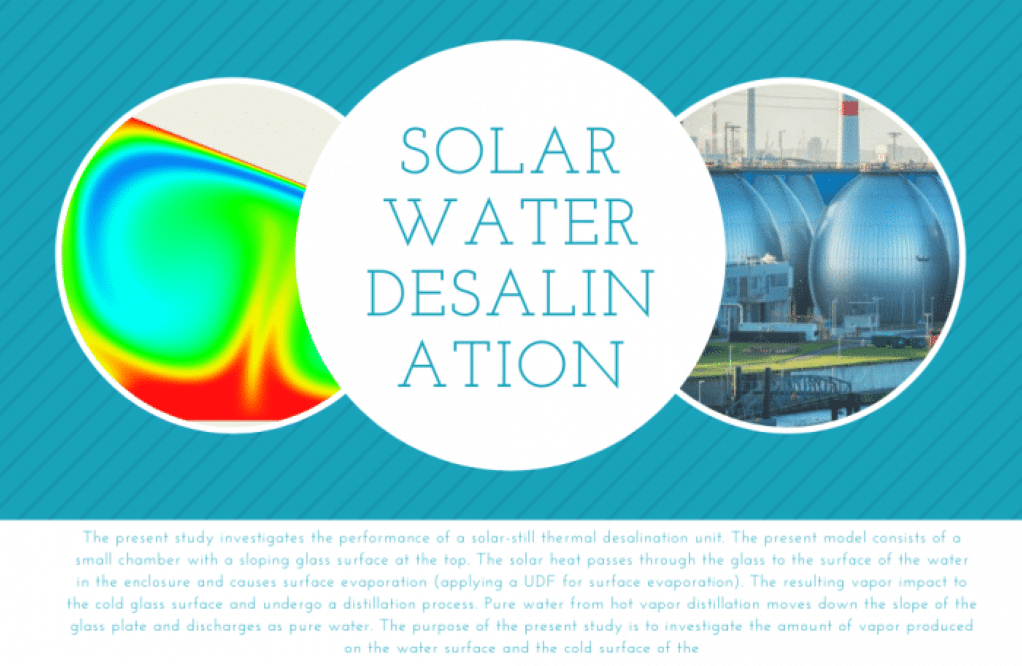
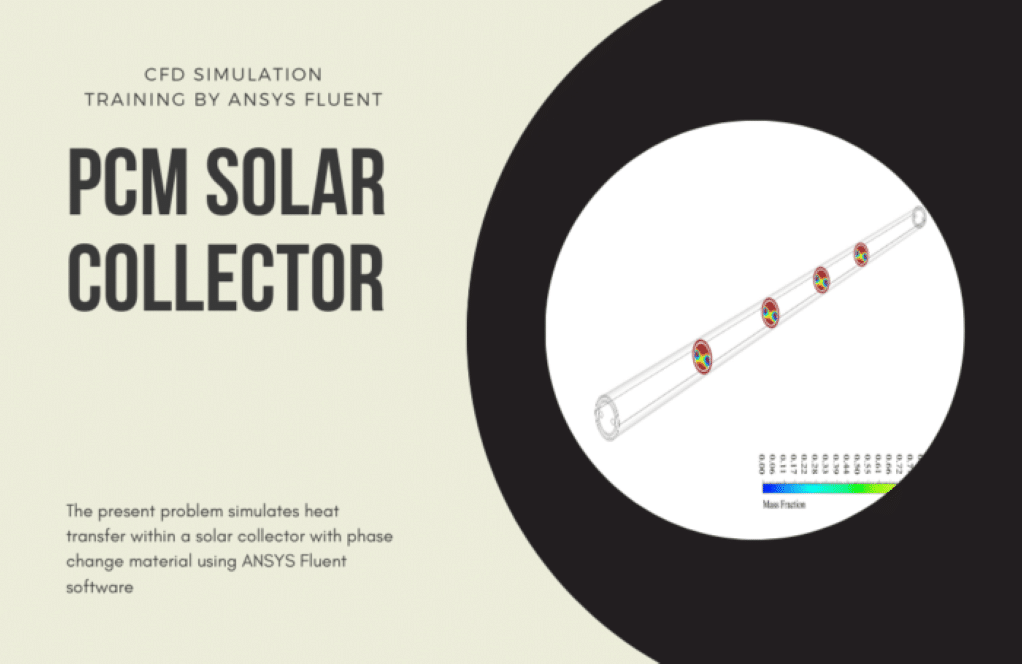
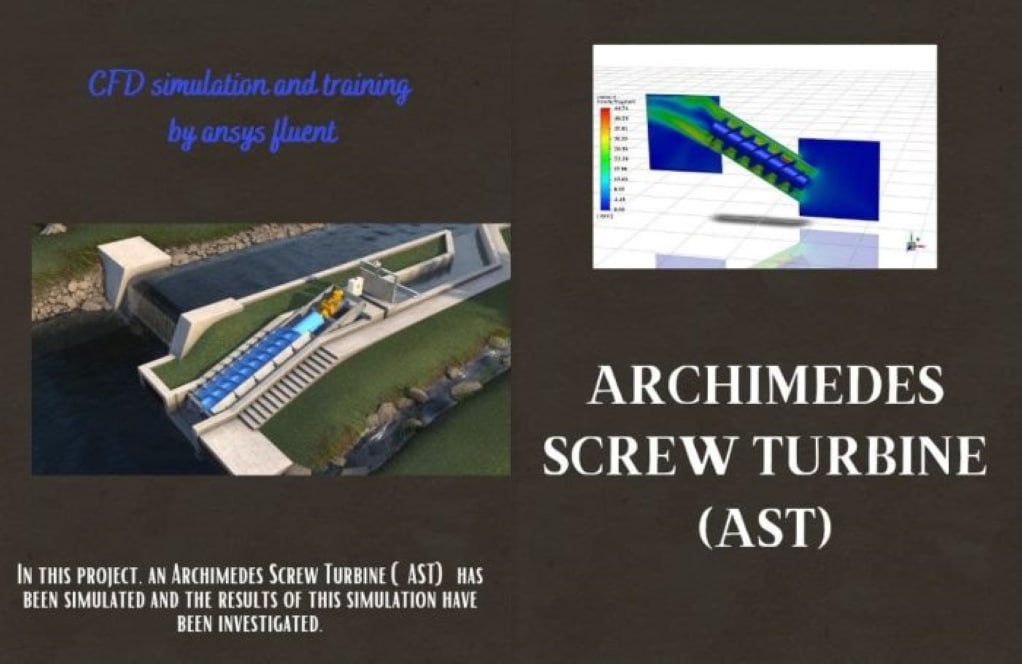
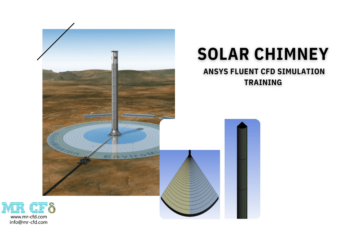
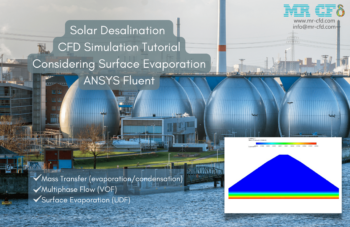
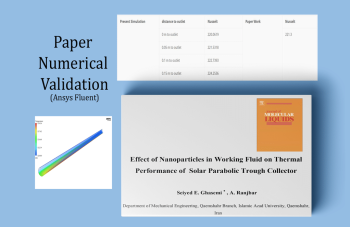
Prof. Vern Grimes –
How does this package handle the simulation of solar thermal energy systems?
MR CFD Support –
This package includes exercises that cover the simulation of solar thermal energy systems. It provides insights into how different factors can impact the efficiency of these systems. We are also open to modifying the simulations to cater to your particular requirements.
Cristobal Rau –
What principles are the biomass energy simulations in this package based on?
MR CFD Support –
The biomass energy simulations in this package are based on the principles of thermodynamics and fluid dynamics. They provide a detailed understanding of how biomass can be used for energy production. We can tailor these simulations to align with your specific needs.
Gaetano Botsford –
I’m curious about the methodology used for the hydroelectric power simulation. Can you elaborate?
MR CFD Support –
Certainly! The hydroelectric power simulation in this package is based on real-world scenarios. It helps you understand how water flow and turbine design can affect power generation. We can also adapt the simulation to fit your unique needs.
Holden Ondricka –
I’m interested in the details of the wind turbine model used in this package. Can you provide more information?
MR CFD Support –
Absolutely! The wind turbine model in our package is based on advanced fluid dynamics principles. It’s designed to give you a comprehensive understanding of wind energy conversion systems. We can also customize the model according to your specific needs
Daisy Shields –
The Renewable Energy Training Package for Advanced Users seems incredibly comprehensive. The step-by-step practical exercises should provide in-depth knowledge of water and solar energies within ANSYS Fluent. The simulations covering turbines, both HAWT, and VAWT and the solar still & desalination are phenomenal practical applications. It sounds like these exercises equip users with crucial CFD techniques for renewable energy systems. It’s amazing how this package takes it a step further to include unsteady CFD simulation, which I can imagine, heightens the learning experience. Looking forward to more enriching CFD learning materials from MR CFD Company!
MR CFD Support –
We appreciate your positive feedback regarding our Renewable Energy Training Package for Advanced Users. It’s always encouraging to hear that our practical exercises and comprehensive approach to teaching CFD for renewable energy applications are well-received. Thank you for highlighting the aspects of the training that impressed you, such as the real-world application of the exercises and the focus on unsteady simulation and Fluid Structure Interaction. We look forward to providing you with more enriching learning materials in the future. Your enthusiasm inspires us to continue creating high-quality, educational content!
Mr. Doug Reichert III –
Thank you for offering such a comprehensive and practical training package on renewable energy. The detailed studies on various types of water turbines and solar energy applications were incredibly insightful. The projects were challenging yet very rewarding, particularly the ones involving Dynamic Mesh and Fluid Structure Interaction in water turbines, as well as the thermal analysis in solar still desalination. I appreciate the way the course was structured, offering a progressive learning curve from the principles to the applied complexities of renewable energy simulations using ANSYS Fluent.
MR CFD Support –
We are thrilled to hear that you found the Renewable Energy – ANSYS Fluent Training Package for ADVANCED Users to be comprehensive and rewarding! Your feedback is very important to us and motivates our team to keep providing high-quality materials for our learners. If you ever have any questions or need further assistance, please don’t hesitate to reach out. Thank you for choosing our training for your educational journey in renewable energy simulations!
Adaline Block –
Just finished the Renewable Energy Training Package for advanced users. The exercises were incredibly comprehensive, and I liked the focus on water and solar energies. Doing the practical simulations sharpened my skills, especially the FSI method’s challenge and managing the dynamic mesh method for VAWT. The solar still simulations for desalination units gave me a clearer understanding of the distillation processes and efficiency in renewable energy applications. Excited to apply these skills in my research!
MR CFD Support –
We’re genuinely thrilled to hear that our Renewable Energy Training Package met your expectations and has empowered you with valuable skills for your research. Your success in mastering the advanced simulations, especially in the nuances of the FSI method and dynamic mesh, is precisely the outcome we aim for with our materials. Thank you for choosing our package for your educational needs, and we wish you the best in your future endeavors in renewable energy!
Amos Herzog –
I’m delighted with the Renewable Energy Training Package for Advanced Users! The practical exercises strengthened my understanding of water and solar energies using ANSYS Fluent. The clear distinction in methodologies such as MRF and Mesh Motion for turbine simulation was highly informative. Overall, the step-by-step guidance through complex systems like the integration of fluid structure interactions (FSI) on water turbines gave me solid insights into real-world renewable energy simulations. Kudos to the team for a well-structured and comprehensive training package!
MR CFD Support –
Thank you for your positive feedback! It’s fantastic to hear that you found the Advanced Users Renewable Energy Training Package both informative and helpful in enhancing your understanding of water and solar energy simulations using ANSYS Fluent. We are pleased to know that the practical exercises and methodological explanations contributed to your learning experience. We appreciate you taking the time to share your thoughts, and we hope our product will support your ongoing education and professional development in renewable energy.
Vanessa Ryan V –
The breadth of topics covered in this training package is impressive. I’m particularly intrigued by the application of the DYNAMIC MESH method in study number 4 and the coupling presented in study number 5. Understanding water flow around different types of turbines is critical in advancing renewable energies, and this package seems to offer a strong foundation in that area.
MR CFD Support –
We appreciate your positive feedback on the Renewable Energy Training Package for Advanced Users. It’s wonderful to hear that you’ve found the in-depth simulations, particularly those involving the DYNAMIC MESH method and Fluid Structure Interaction (FSI), both intriguing and informative. We aim to provide comprehensive materials that empower our users to analyze and understand complex dynamics in renewable energy technology. Thank you for taking the time to complement the package.
Aaron Robel –
Just completed the ADVANCED Renewable Energy training package by MR CFD focused on WATER and SOLAR energies. Fascinating combination of theory and practical exercises that solidified my understanding of complex simulations in renewable energy. Handling different simulation strategies for water turbines and studying solar power, from desalination systems to solar collectors, have significantly upgraded my skills. The detailed approach to each project, especially the one involving the Pelton turbine, was remarkably informative. The progression from simpler water-energy focused tasks to intricate solar-energy simulations was seamless. These exercises leveraged ANSYS Fluent effectively, showcasing real-world applications with thorough analysis. Highly recommended for professionals seeking depth in CFD applications in renewable energy systems!
MR CFD Support –
Thank you for your great feedback! We are delighted to hear that you found the ADVANCED Renewable Energy training package informative and helpful in expanding your expertise in renewable energy simulations using ANSYS Fluent. Our goal is to provide practical, hands-on experience with real-world applications, and it’s encouraging to know that we are succeeding. We truly appreciate you taking the time to recommend our training package and look forward to supporting you in your future CFD endeavors.
Kurt Abbott –
I recently completed the Renewable Energy Training Package for Advanced Users and I must say, I’m extremely impressed! The training surpassed my expectations with its in-depth practical exercises on water and solar energy using ANSYS Fluent. Perfect for someone looking to strengthen their expertise in CFD for renewable energy applications. Kudos to the team for creating such comprehensive and well-structured exercises!
MR CFD Support –
Thank you so much for taking the time to leave such a positive review! We’re thrilled to hear that the Renewable Energy Training Package for Advanced Users met, and even surpassed your expectations. Our team puts a lot of effort into developing comprehensive and engaging training materials, and it’s rewarding to know that it’s making a difference. If you ever have any further feedback or need support as you apply what you’ve learned, please don’t hesitate to reach out. We’re here to help!
Alexandra Welch PhD –
I’ve just finished the Renewable Energy Training Package, focusing on WATER and SOLAR energies, and wow, I’m thoroughly impressed! Not only was it intriguing to see the detailed simulations of water turbines and solar energy systems, but the depth of knowledge presented in practical exercises was exceptional. The contrast between Frame Motion and Mesh Motion in the Archimedes Screw Turbine simulation was a real eye-opener which influenced a great deal of understanding about rotating machinery simulations…
MR CFD Support –
We are absolutely thrilled to hear that you enjoyed the Renewable Energy Training Package! It’s wonderful to know that the practical exercises provided you with a deep understanding of both water and solar energy simulations. Knowing that those insights into Frame Motion vs. Mesh Motion were enlightening is immensely gratifying for us. Thank you for your positive feedback, and we appreciate you taking the time to share your learning experience. We endeavor to offer comprehensive and engaging training, and we’re glad you found it to be so!
Mrs. Jazmin Buckridge –
I recently completed the Renewable Energy Training Package for Advanced Users. The diversity of practical exercises significantly improved my understanding of CFD applications in renewable energy systems, and utilizing ANSYS Fluent’s capabilities proved to be invaluable for my research work.
MR CFD Support –
We are thrilled to hear that you found our Renewable Energy Training Package beneficial for your studies and research. Your positive feedback motivates us to continue providing high-quality learning resources. Thank you for choosing our training materials to advance your knowledge in renewable energy and CFD applications.
Houston Daugherty –
I’ve completed the Renewable Energy Training Package for Advanced Users, and it was a fantastic learning experience! The diverse range of practical exercises provided an in-depth understanding of water and solar energies. Each project was challenging and informative, particularly the solar still & desalination studies and the application of fluid-structure interaction methods. The explanations were clear, and the use of ANSYS Fluent pushed me to develop advanced CFD skills. Highly recommend for those looking to sharpen their knowledge in renewable energy simulations!
MR CFD Support –
We are thrilled to hear that you found our Renewable Energy Training Package for Advanced Users beneficial and challenging. It’s our aim to provide comprehensive educational experiences, and we’re glad the exercises added to your skillset in renewable energy and CFD applications using ANSYS Fluent. Thank you for your recommendation, and we wish you continued success in your future projects!
Gabe Cartwright PhD –
I really enjoyed the Renewable Energy Training Package for Advanced Users. Each practical exercise was well-structured and significantly enhanced my understanding of CFD applications in renewable energy. Working through water and solar energy simulations expanded my skill set immensely. I especially found the inclusion of Fluid Structure Interaction in exercise 5 and the solar desalination studies very enlightening, demonstrating complex real-world problem-solving. A perfect blend of challenges and learning!
MR CFD Support –
Thank you for your positive review! We are thrilled to hear that the Renewable Energy Training Package met your advanced learning needs and that the practical exercises helped deepen your understanding of CFD applications in renewable energy. It’s great to know that you found the Fluid Structure Interaction and solar desalination studies enlightening. We appreciate your feedback and are pleased that our package provided you with a rewarding learning experience. If you have any further insights or need assistance in future, don’t hesitate to reach out!
Camylle Trantow –
This Renewable Energy Training Package sounds incredibly comprehensive! The depth of each exercise, especially in the fields of water and solar energy, showcases a highly specialized set of CFD simulations tailored for advanced users. Being able to have access to applied and theoretical understanding through practical exercises is brilliant. The specifics of each project give a real-world feel to the material, elevating it beyond mere academic study.
MR CFD Support –
Thank you so much for your thoughtful review! We are thrilled to hear that you found the training package comprehensive and practical. We do our best to ensure our advanced users have access to in-depth and realistic exercises that help build a strong understanding of applying CFD methods to renewable energy projects. Your feedback is very appreciated, and we look forward to providing you with more valuable learning materials!
Prof. Jillian Carter –
I recently completed the Renewable Energy Training Package for Advanced Users and was thoroughly impressed with the diversity and depth of the exercises. The practical focus on both water and solar energy applications using ANSYS Fluent provided an invaluable hands-on experience. The Archimedes Screw Turbine simulation gave me a complete understanding of unsteady Frame and Mesh Motion, while hands-on work with Pelton Wheel, HAWT, and VAWT expanded my knowledge of water turbines significantly. The solar simulations, including study numbers 6 through 10, offered a fascinating look into thermal desalination, surface evaporation processes, and PCM solar collectors, rounding out my skills in solar energy analysis. This comprehensive package brilliantly caters to the needs of advanced users seeking to solidify their understanding of CFD applications in renewable energy.
MR CFD Support –
Thank you for taking the time to provide your thoughtful and detailed feedback. We’re thrilled to hear that you found the Advanced Renewable Energy Training Package both impressive and educational. Our objective is always to deliver comprehensive learning experiences, and it’s rewarding to know that this training has expanded your knowledge and skills in the field of renewable energy through practical, real-world simulations. If you have further questions or require additional learning resources in the future, please don’t hesitate to reach out to us.
Dr. Loma O’Kon MD –
What an excellent set of training exercises for an advanced user looking to delve deep into renewable energy simulations using ANSYS Fluent! The detailed description of each experiment clarifies the skillset required to tackle such sophisticated CFD projects. The various methods applied—from MRF to Dynamic Mesh—clearly indicate a comprehensive understanding of the fluid dynamics challenges in renewable energy applications.
MR CFD Support –
Thank you for your glowing review! It’s wonderful to hear that you appreciate the comprehensive and advanced level of our Renewable Energy Training Package. We’re pleased that the variety of projects and the diverse CFD methods included are to your satisfaction. We hope it empowers users to confidently tackle complex simulations in their renewable energy endeavors.
Dr. Cody Olson –
I’ve made significant progress in my understanding of CFD applications in renewable energy through the Renewable Energy Training Package. The practical exercises were particularly impactful, reinforcing advanced concepts in water and solar energy simulations with clarity and depth. I appreciate the sophisticated approach adopted in each project that allowed me to study complex phenomena and improve my skills in ANSYS Fluent.
MR CFD Support –
Thank you for taking the time to provide such positive feedback on our Renewable Energy Training Package for Advanced Users. We’re delighted to hear that the practical exercises proved beneficial to your CFD learning journey and helped deepen your understanding of renewable energy simulations. If you have any further inquiries or require assistance with future simulations, don’t hesitate to reach out to us. We’re here to support your continued progress in mastering ANSYS Fluent.
Dr. Ayana Trantow –
The Renewable Energy Training Package seems incredibly detailed and right up my alley as an advanced user! I especially appreciate the inclusion of both solar and water energy applications with practical exercises.
MR CFD Support –
Thank you for your positive feedback! We are thrilled to hear that our Renewable Energy Training Package meets your expectations and provides the detailed insights you are looking for as an advanced user. Should you need any further assistance or information on the exercises, feel free to reach out.
Whitney Johnston –
The Renewable Energy Training Package seems comprehensive, focusing on practical implications in ANSYS Fluent. It’s great to see a balance of water and solar energy projects!
MR CFD Support –
Thank you for your positive feedback on our Renewable Energy Training Package for Advanced Users. We are glad that you appreciate the comprehensiveness and practical focus of our learning exercises, combining water and solar energy simulations. Your satisfaction is our priority. We remain committed to offering valuable learning experiences.
Dale Pollich Jr. –
The Renewable Energy Training Package seems incredibly thorough! The diversity of studies on both water and solar energies must offer a vast wealth of practical knowledge. I’m impressed by the way it covers complex topics like fluid structure interaction and solar desalination.
MR CFD Support –
Thank you for your kind words! We are glad to hear that the training package has met your expectations and you are satisfied with the depth of content it covers in both water and solar energy. We always strive to provide a comprehensive and practical learning experience, and it’s very rewarding to hear positive feedback from our customers!